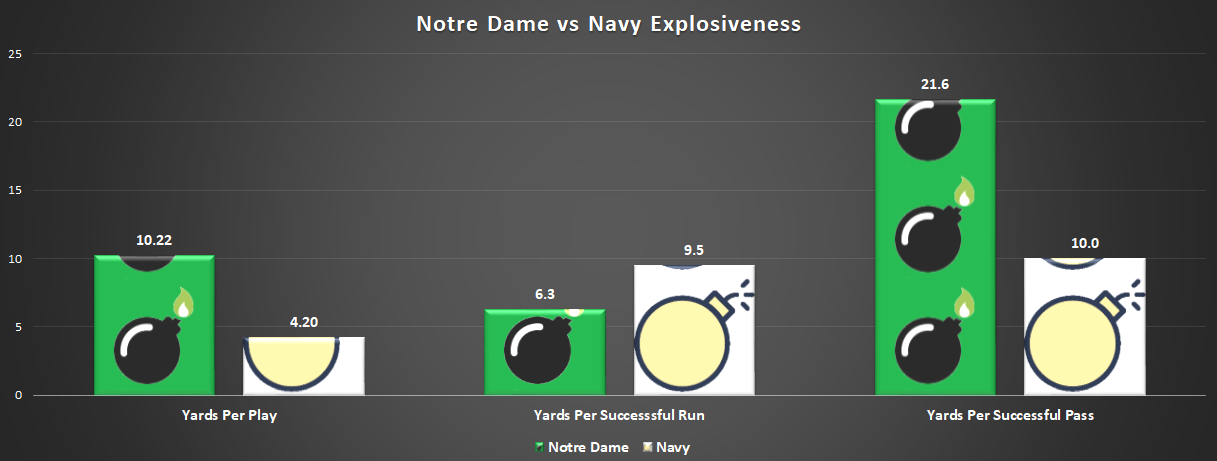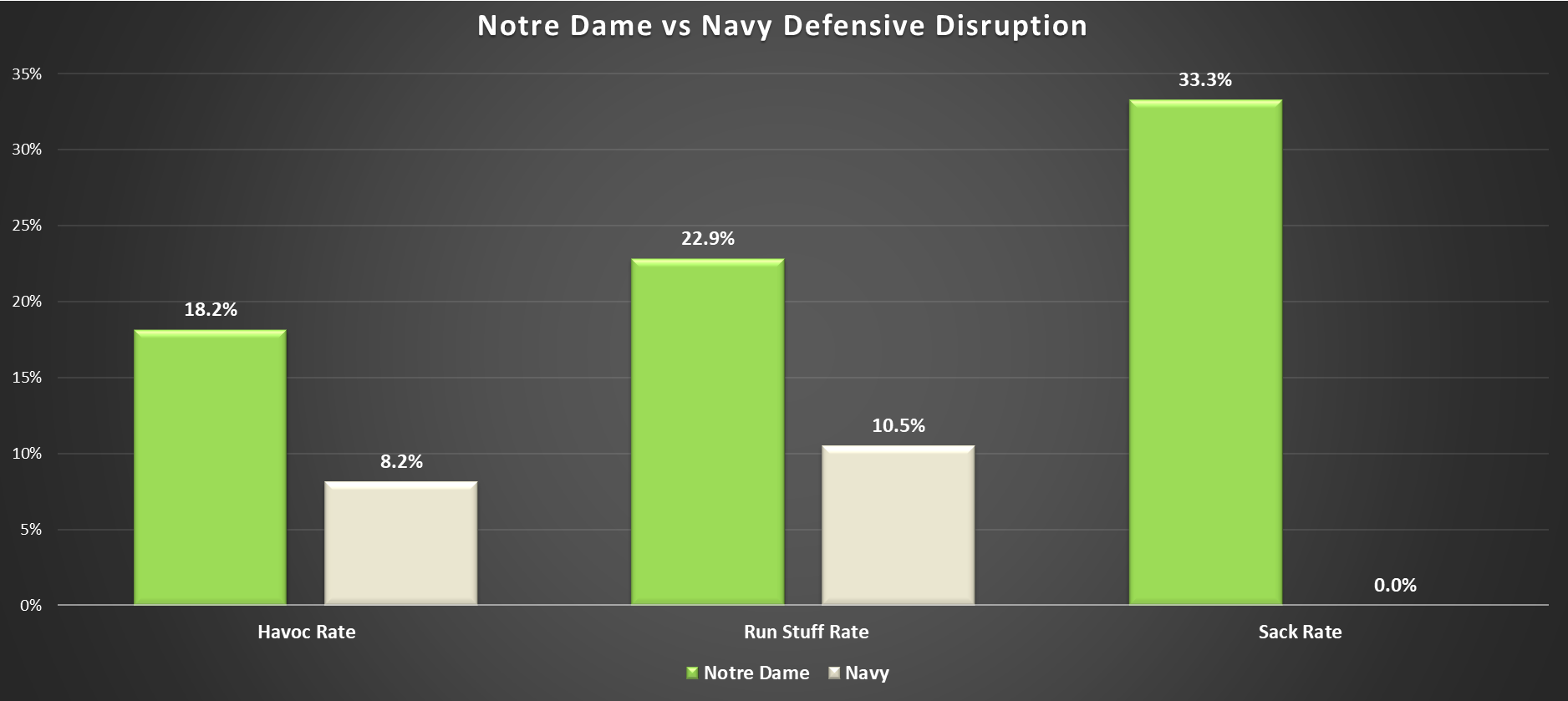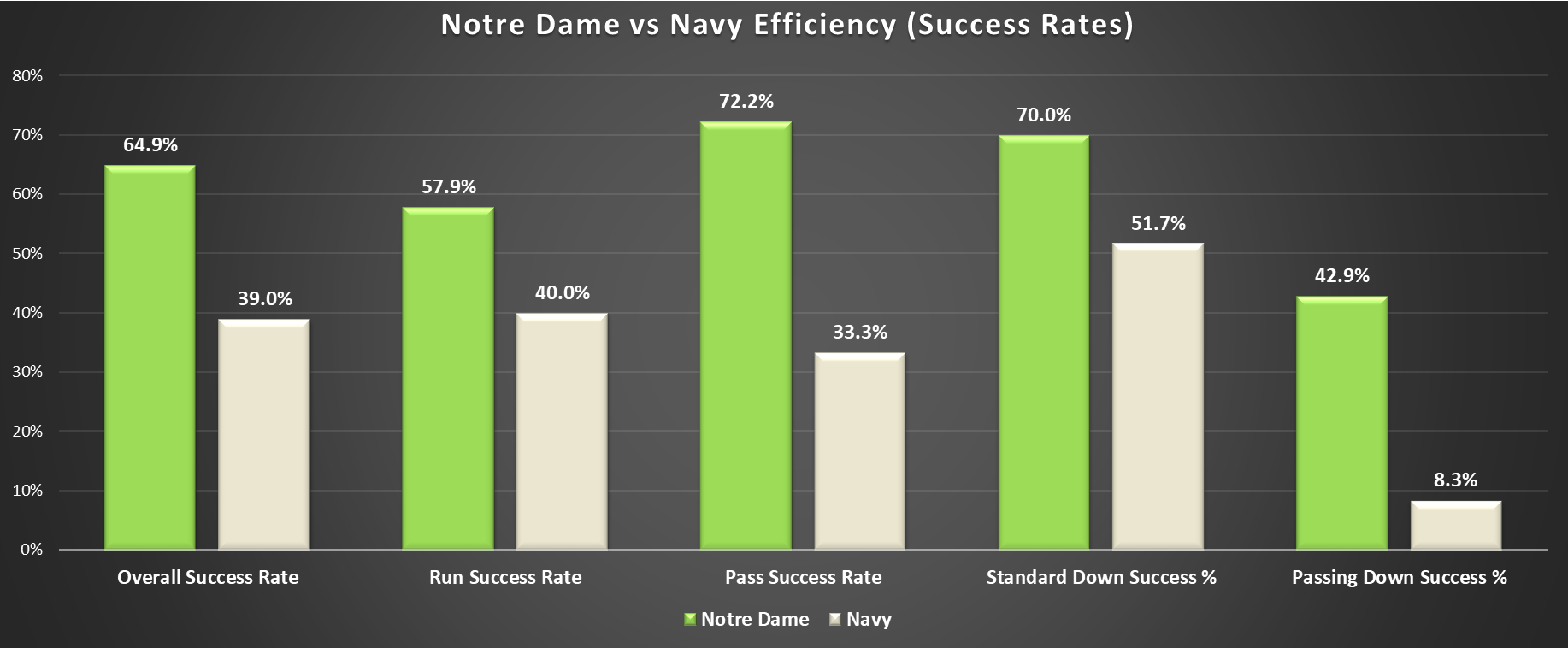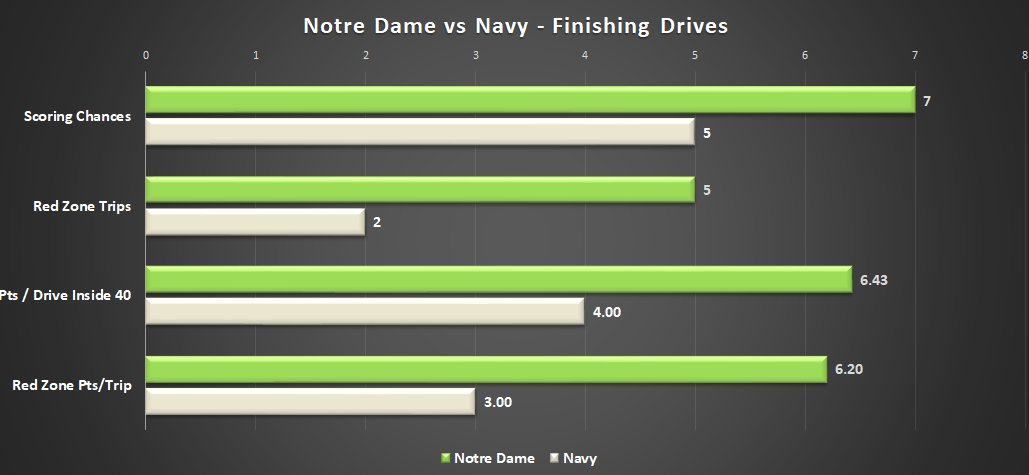The Irish checked all the boxes for a perfect game against Navy – scoring every possession early, forcing turnovers and passing downs, and limiting first down yardage. Second-half garbage time stats obscure in the final box score what was an incredibly dominant performance by Notre Dame against a Navy team that’s still competing for the AAC title.
Garbage time per SP+ definition would begin at halftime or even earlier (+38 in Q2, +28 in Q3). In this one the cut-off where objectives clearly changed was when Ian Book went to the bench after an Irish touchdown put Notre Dame up 45-3. Malcolm Perry stayed in for one additional Navy drive, but scrapping plays from this point forward puts 38% of plays in garbage time.
Saturday’s blowout is also a case study for the value of advanced stats that exclude garbage time. Not that yards per game should be used in the first place, but is 281 yards rushing allowed in any way reflective of how the Notre Dame run defense performed? Not when they held Navy to 4.54 yards per carry before the game was well out of hand. Likewise, the Irish offense was dominant (10.2 yards/play) before Book exited and the offense turtled (3.17 yards/play after that point). The Irish were outgained by 150 yards and 2.1 yards a play with second-stringers in, and none of it was really relevant to the outcome of the game or even the spread!
Explosiveness

It was fair coming into this game to wonder if everything would truly click for the Irish at any point this season. At different points, every part of the team has flashed brilliance, but against real competition, the closest this edition of the Irish had come was the prior week’s win at Duke, a satisfying and thorough beating yet still a semi-clunky performance and against an opponent that was hard to fear.
Finally, in game ten, virtually every good version of Notre Dame showed up at once. Peak Ian Book arrived and showed that along with Chase Claypool and Braden Lenzy he could toy with a Navy defense that had been extremely disruptive. Clark Lea nearly shut out the Navy offense in the first half for a second consecutive year.
It’s easy and frustrating for critics to play the “ain’t played nobody” card on Navy, but this level of dominance on a ranked opponent shouldn’t be taken lightly. Per Bill Connelly’s numbers from the full 2013 season, teams that out-gained their opponents by 5+ yard per play win 100% (yes, every time) with an average margin of victory of over 50 points. The Irish did one better and outgained the Midshipmen by 6 YPP, averaging an Oklahoma-like 10.2 yards a play before the first team received a well-deserved rest.
While Book and Claypool stole headlines, let’s first focus in detail on Lea and the Irish defense. We should never, ever take for granted this type of performance against the triple option, whatever the talent advantage. It’s a pain in the ass for everyone, including programs like Alabama, that in peak Saban-era has had Georgia Southern come within 10 points well in the 3rd quarter and run for 7.7 yards per carry running the triple.

There was certainly some good luck involved – the Irish recovered all four Navy fumbles in the game, and the Midshipmen moved the ball with their patented efficiency early in the game (61% success rate on first two drives) when they weren’t turning it over. But those opportunities were also borne out of defensive disruption, as the Irish defense was able to generate negative plays that threw the Navy offense off schedule and Malcolm Perry quickly out of rhythm.
- First Navy drive: three-yard TFL on 1st down forces eventual 4th and 3 that Perry barely converts, Kareem forces fumble next play
- Second: 1st down stuff and Owusu-Koramoah sack forces 3rd and 13 where again Kareem forced fumble
- Third: another TFL on 1st down forces a 2nd and long, then another sack, then 3rd and 18 Navy isn’t built to convert
- Fourth: A break in disruption for Navy but no long gains leads to a 4th and 1 that Kyle Hamilton eliminates
- Fifth: Navy is now down 31-0 and Ken Niumatalolo’s gameplan has been set ablaze. Perry fumbles a snap, the Irish recover, and it’s a wrap with more than half an hour still on the clock
Scoring touchdowns on the first three possessions and establishing a 21-point lead before the Middies had their third possession was the ideal formula. Typically, part of any team’s struggle against Navy is the pressure the triple places on the offense, even one as talented as Notre Dame. There’s an understanding that there won’t be many possessions and that an empty drive or two could be the difference in the game if the triple is humming. The early defensive stops paired with flawless offensive execution sucked that potential tension out of the stadium early and translated into a team that played fast and free.
Efficiency

This was the most efficient passing performance of the year for Ian Book, a glimpse of the promise many projected over the offseason and that maybe still lies ahead. Book was efficient and explosive, completing some beautiful deep balls en route to averaging an absurd 15.8 yards per pass attempt. Amid Claypool’s record-tying day it was heartening to see Book utilize an array of weapons with the long bomb to Lenzy, a couple of nice throws to Lawrence Keys, and Chris Finke getting wide open.
By comparison, the Irish rushing attack was far less glamorous but still averaged just under five yards per carry and had terrific efficiency. The passing game was the driving force of the offense, with the run game utilized to pick up a lot of shorter first downs with five successful runs of three yards or fewer. With the lack of explosiveness from Notre Dame’s running backs (a long run of 12 yards), this feels like the right role for the run game to close out the season.
The defense held the usually hyper-efficient Navy offense to pedestrian success rates, capitalizing on chances when the Midshipmen offense was forced into passing downs. Although Navy runs in those situations more than most teams, they entered the game with a more dangerous passing attack than in most years, and couldn’t get anything going. The Middies averaged just 3.6 yards per 1st down play and had an average of 7.5 yards to go on 3rd down. That’s not a formula for success in that offense.
Finishing Drives, Field Position, & Turnovers

The Irish continued their red zone excellence this season, scoring touchdowns on four of five visits. Notre Dame created scoring opportunities on all seven possessions before garbage time, with touchdowns on six of them. Meanwhile, Navy created just two scoring opportunities before garbage time and came away with three points.
A massive advantage early in the game was a far shorter field for the Irish offense to work with then Navy. Thanks to turnovers and a critical 4th down stop, Notre Dame’s average starting field position pre-garbage time was their own 43-yard line. And since the ND offense scored every possession and Navy couldn’t get anything in the kick return game, Navy’s average possession started at their own 23.
Turnovers played a huge role in the game but I’m not sure they did much more than accelerating the blowout. It wasn’t great lucky for Navy to close all four fumbles, but they’d still have been expected to turn it over around 2.7 times based on putting the ball on the ground so often and pass break-ups. Navy had only one pass breakup in the game, so Notre Dame’s expected turnovers were only 0.22.



